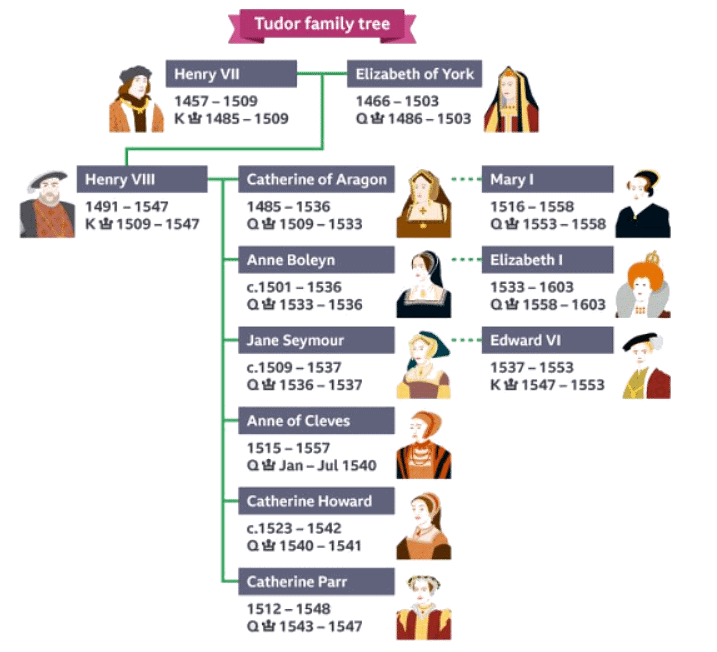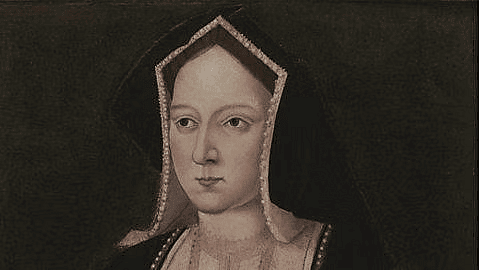Year 7 Exam > Year 7 Notes > Who was Henry VIII?
Who was Henry VIII? - Year 7 PDF Download
| Table of contents |

|
| Introduction |

|
| The Tudor Family |

|
| Who was the young Henry VIII? |

|
| Henry VIII's foreign policy |

|
| Religion |

|
| Government under Henry VIII |

|
| Marriages and children |

|
Introduction
- Henry VIII, a Tudor monarch, reigned over England from 1509 to 1547, known for his six marriages and the harsh treatment of his wives.
- His primary aim was to attain military triumphs and elevate the prestige of his realm.
- One pivotal event during his rule was his break from the Catholic Church to establish the Church of England, leaving a lasting impact.
The Tudor Family
- Henry VIII’s father, Henry VII, established the Tudor dynasty in 1485.
- During Henry VII’s reign, the Wars of the Roses occurred. This conflict between the houses of Lancaster and York from 1455 to 1487 was a struggle for the English throne.
- Henry VII emerged victorious towards the end of this conflict.
- He married Elizabeth of York, expanding the family, and was succeeded by his son, Henry VIII, followed by his grandchildren Edward VI, Mary I, and Elizabeth I. The Tudors held power from 1485 to 1603.

Question for Who was Henry VIII?Try yourself: Who was the father of Henry VIII?View Solution
Who was the young Henry VIII?
- The future Henry VIII was the second son of Henry VII, which initially placed his older brother Prince Arthur as the designated future ruler. Prince Henry was raised separately from his brother at a different palace, alongside his mother and sisters.
- Despite his position as the second son, Prince Henry displayed remarkable intelligence and talents. He showed proficiency in music, enjoyed jousting, and was proficient in several languages, typical of royal upbringing. His exceptional education garnered admiration from prominent scholars like Erasmus, who praised Henry's regal demeanor and intellect, despite his young age of nine when they first met.
- Tragedy struck in 1502 when Prince Arthur passed away, followed by the death of their mother, Elizabeth of York, a year later. Subsequently, Henry was required to live with his father, an adjustment that proved challenging for the young prince. During this period, he seldom made public appearances and was under constant supervision.
- Upon his father's death in 1509, Henry VIII ascended to the throne of England. Eager to leave his mark, he swiftly began establishing a magnificent court with his new wife, Catherine of Aragon, who had previously been married to his deceased brother, Arthur.
Henry VIII's foreign policy
- Henry VIII aspired to emulate the military successes of his predecessor, Henry V, by conquering France.
- His initial attempt to invade France in 1512 ended in failure due to the lack of support promised by his father-in-law, Ferdinand II of Aragon. Additionally, many of Henry's troops fell ill while awaiting reinforcements.
- A second invasion in 1513 proved more successful, with Henry's army achieving victory over French forces at the Battle of the Spurs and capturing the towns of Thérouanne and Tournai. To commemorate this triumph, Henry commissioned grand paintings of the campaign, displayed at Hampton Court Palace.
- Throughout his reign, Henry engaged in prolonged wars with France and Scotland, traditional adversaries of England. These military endeavors drained the royal coffers, leading Henry to levy increasingly burdensome taxes and accrue substantial debts.
- Seeking to enhance England's diplomatic standing in Europe, Henry pursued peacemaking initiatives by convening peace summits between royal families. Collaborating with his minister Cardinal Thomas Wolsey, Henry organized notable gatherings such as the Field of Cloth of Gold, aimed at fostering peace and diplomatic alliances among European powers.Henry VIII aspired to emulate the military successes of his predecessor, Henry V, by conquering France.
- His initial attempt to invade France in 1512 ended in failure due to the lack of support promised by his father-in-law, Ferdinand II of Aragon. Additionally, many of Henry's troops fell ill while awaiting reinforcements.
- A second invasion in 1513 proved more successful, with Henry's army achieving victory over French forces at the Battle of the Spurs and capturing the towns of Thérouanne and Tournai. To commemorate this triumph, Henry commissioned grand paintings of the campaign, displayed at Hampton Court Palace.
- Throughout his reign, Henry engaged in prolonged wars with France and Scotland, traditional adversaries of England. These military endeavors drained the royal coffers, leading Henry to levy increasingly burdensome taxes and accrue substantial debts.
- Seeking to enhance England's diplomatic standing in Europe, Henry pursued peacemaking initiatives by convening peace summits between royal families. Collaborating with his minister Cardinal Thomas Wolsey, Henry organized notable gatherings such as the Field of Cloth of Gold, aimed at fostering peace and diplomatic alliances among European powers.
Religion
- During the Tudor era, like many others, Henry VIII held the belief that men should be the rulers of the land. His desire was to have a male heir to inherit the throne after his passing. However, his only surviving child from his first marriage was a daughter named Mary.
- In the 1520s, Henry VIII sought to annul his marriage, a process that is distinct from divorce and can be granted by the Catholic Church, effectively rendering the marriage legally null and void. He claimed that his marriage to his deceased brother's widow had left him without a male heir, even though he had a daughter. Henry interpreted a Bible verse to mean 'sonless,' reinforcing his determination for an annulment.
- Henry's request for the annulment was submitted to the Pope for consideration. The Pope permitted Henry to hold the trial in England and assigned Cardinal Campeggio to oversee the proceedings. Following extensive discussions and debates, the Pope ultimately denied Henry the annulment he sought.
- Disappointed by the lack of a male heir and influenced by Protestant literature challenging papal authority, Henry VIII sought to take decisive action. In January 1533, he married Anne Boleyn and established the Church of England. With support from his ministers and Parliament, Henry asserted his supremacy over the English Church, effectively making himself its head instead of the Pope.
Question for Who was Henry VIII?Try yourself: Who was the designated future ruler before Henry VIII?View Solution
Government under Henry VIII
- There's ongoing debate among historians regarding Henry VIII's governance and the extent to which he delegated power to his ministers and advisors.
- Initially, Henry's days were filled with leisure activities like hunting and jousting, but he also attended to state affairs after Mass each day. Initially, he relied on a council for advice but later leaned heavily on key figures such as Thomas Wolsey and Thomas Cromwell, who served as ministers assisting him in governing the country.
- Despite having trusted advisors, Henry retained ultimate authority. When they failed, they faced severe consequences. Wolsey died while en route to prison after failing to secure Henry's divorce from Catherine of Aragon. Cromwell was executed in 1540 on charges of treason, with many attributing his downfall to his support of religious reformers and his role in Henry's unsuccessful marriage to Anne of Cleves.
- The Reformation bolstered Henry's power in several ways. Firstly, he assumed the title of Supreme Head of the Church of England, a significant move given the nation's religious fervor. Secondly, he utilized Parliament to advance his agenda. In 1539, Henry passed the Statute of Proclamations, granting him authority to enact changes to governance by decree rather than through traditional legislative channels.
Marriages and children
Henry VIII is renowned for marrying six wives, with three of them bearing heirs to the throne. His treatment of his wives is famously depicted in the rhyme: 'divorced, beheaded, died, divorced, beheaded, survived'.
- Catherine of Aragon: Catherine of Aragon, a Spanish princess and daughter of King Ferdinand and Queen Isabella, was groomed to be the future Queen of England. She wed Henry's elder brother, Prince Arthur, in 1502 after a lengthy journey from Spain. Following Arthur's passing, Catherine found herself stranded in England. Her marriage to Henry in 1509 lasted 24 years. Despite several pregnancies, only one child, Mary, survived. Catherine steadfastly believed she was the rightful English queen until her demise in 1536.
- Anne Boleyn: Anne Boleyn spent her early years in France at the court of Francis I before returning to England in the 1520s. She caught the attention of Henry VIII upon joining his court. Anne was known for her intelligence, education, and outspoken nature. She openly expressed her frustrations regarding Henry's divorce from Catherine, even confronting him publicly.
- Life and Tragic End: Anne became queen in 1533 and gave birth to Elizabeth that same year. Unfortunately, in 1536, she faced false charges of treason and adultery, leading to her unjust execution alongside five others, including her brother.
- Jane Seymour: Jane Seymour, who served as a lady-in-waiting to Anne Boleyn, lacked the same level of education as Catherine or Anne but excelled in needlework. Henry VIII turned his attention to Jane shortly after Anne's death.
- Tragic Fate: Jane married Henry shortly after Anne's execution and bore him a son, Edward, in 1537. Sadly, she passed away due to complications from childbirth shortly after giving birth. Henry was eventually buried next to her upon his death in 1547.
FAQs on Who was Henry VIII? - Year 7
| 1. Who was Henry VIII's father? |  |
Ans. Henry VIII's father was King Henry VII of England.
| 2. How many wives did Henry VIII have? |  |
Ans. Henry VIII had six wives throughout his life.
| 3. What was Henry VIII's relationship with the Catholic Church? |  |
Ans. Henry VIII famously broke away from the Catholic Church and established the Church of England.
| 4. How many children did Henry VIII have? |  |
Ans. Henry VIII had three legitimate children who survived infancy: Mary I, Elizabeth I, and Edward VI.
| 5. What was Henry VIII's foreign policy like during his reign? |  |
Ans. Henry VIII pursued an aggressive foreign policy, engaging in wars and alliances to secure England's position in Europe.
Related Searches













